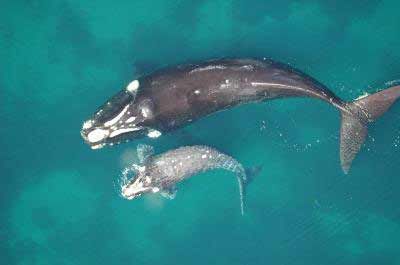Mysterious Whale Die-Off Is Largest on Record

Mass death among baby right whales has experts scrambling to figure out the puzzle behind the largest great whale die-off on record.
Observers have found 308 dead whales in the waters around Peninsula Valdes along Argentina's Patagonian Coast since 2005. Almost 90 percent of those deaths represent whale calves less than 3 months old, and the calf deaths make up almost a third of all right whale calf sightings in the last five years.
"This is the single largest die-off event in terms of numbers and in relation to population size and geographic range," said Marcela Uhart, a medical veterinarian with the Wildlife Conservation Society (WCS). She represents an associate director in Latin America for the WCS Global Health Program.
Meeting on the mystery
To get to the bottom of the baby-whale mystery, the scientific committee of the International Whaling Commission (IWC) convened an urgent meeting at a workshop in Puerto Madryn, Argentina, this month.
Only a few clues have emerged so far regarding the cause of death, such as unusually thin layers of blubber on some dead calves. Whale calves typically have lower chances of survival during their first year of life, but the high rate of death at Peninsula Valdes is unique.
Southern right whales are baleen whales that filter their tiny prey from the water with their comb-like mouths. They once represented an ideal target for whalers and nearly went extinct, but began to rebound after a whaling ban started during the1930s. Still, the whales remain listed as endangered and have yet to recover anywhere close to their historic population levels of 60,000 or more.
Sign up for the Live Science daily newsletter now
Get the world’s most fascinating discoveries delivered straight to your inbox.
Health experts and biologists have yet to reveal exactly what type of death has recently stalked the young right whales. But experts at the IWC meeting agreed that it's unlikely the main cause of death came from killer whale attacks, disturbances from whale-watching boats, vessel strikes or fishing gear entanglement, Uhart told LiveScience.
"These last two mortality factors are the main causes contributing to the near extinction of northern right whales [near the] Eastern U.S.," Uhart explained. North Atlantic right whales represent a separate species from southern right whales, and remain even more endangered with just around 350 surviving individuals.
Possible causes
Ruling out some factors for the southern right whale deaths leaves possible causes, such as harmful biotoxins created by algae or other organisms, disease, environmental factors at the nursing grounds or lack of prey at the whales' feeding grounds.
Official results from the workshop about the cause of death will be released after review and approval at the IWC's annual meeting scheduled to take place in Morocco in June.
The last huge die-off for great whales — including all baleen whales and sometimes the sperm whale — took place in the Eastern Pacific from 1999-2000. More than 250 gray whales showed up dead between Alaska and Mexico during that incident.
That gray whale population is much larger than the southern right whale population around Peninsula Valdes, and so the most recent die-off of southern right whales represents a bigger toll in both a numerical and proportional sense.
Still, there's some reason for hope amidst the uncertainty. Southern right whale populations near Australia and South Africa have escaped the mass death that has stricken the right whales around Argentina.
"Even though the population at Valdes seems to be suffering unusually high calf mortalities, all other southern right whales seem to be doing well," Uhart said.
- Gallery: The World's Biggest Beasts
- 10 Scariest Sea Creatures
- Why Whales Sing
